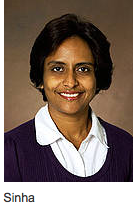 An NDSU researcher is using a federal grant to study the structure of a protein critical to maintaining cellular health.
An NDSU researcher is using a federal grant to study the structure of a protein critical to maintaining cellular health.
Sangita Sinha, associate professor of chemistry and biochemistry, received a four-year, $890,900 award from the National Science Foundation to understand the structure and mechanism of a protein called Beclin 1. Understanding the structure of Beclin 1 and its role in various diseases could lead to drug development and therapies for Alzheimer’s disease, cancer, heart failure and stroke.
Beclin 1 is crucial to cellular autophagy, which is the process cells use to remove unwanted or harmful components. It occurs in organisms ranging from yeast to humans. Beclin 1 and autophagy are required for embryonic development, cellular growth and surviving stresses such as damaged cellular components, UV radiation and pathogens such as herpes virus or HIV.
Beclin 1 binds to more than 20 cellular or viral proteins, which act as chemical communicators telling Beclin 1 what autophagy levels the cell needs to survive.
“It’s a flexible molecule,” Sinha said. “It changes structure when binding with other proteins, sometimes drastically.”
Sinha expects her research will explain how Beclin 1 interacts with so many partners. Ultimately, such information will enable scientists to develop strategies to trap Beclin 1 in different states to regulate autophagy levels in the cell. But first, she must find out what Beclin 1 itself looks like.
“That’s our scientific focus—what does this look like in various states of interaction?” Sinha said. “First we need to find out what it looks like in the basal state, when it is not interacting with other proteins.”
The first step is to clone the gene for Beclin 1 to overexpress the recombinant protein in a bacterial solution. Sinha grows bacteria in six- to 12-liter batches and then harvests the protein from that. The goal is to have enough Beclin 1 to create protein crystals at least 50 microns in diameter. It’s a time-consuming step, difficult in part because the crystals are 70 percent water like the human body.
“Living things are made of proteins,” Sinha said. “And like living things, proteins are very fragile.”
The third step is X-ray crystallography. Researchers, including graduate student Yang Mei, use a high-powered microscope to “scoop” the tiny crystals out of solution. Sinha uses NDSU’s macromolecular crystallography laboratory – the first of its kind in the state – to help determine the structure of the protein. Or she drops the crystals into liquid nitrogen and ships them to Argonne National Laboratory, where she uses a photon accelerator to shoot high-intensity X-rays at the crystals.
The data from the X-ray interaction is used to determine the atomic structure of the protein. Work from her laboratory represents the first time such research has been successfully done in North Dakota, Sinha said.
Sinha received the grant in August 2014. She is beginning to use the results to paint a detailed picture of Beclin 1’s structure.
Sinha earned a doctorate in biochemistry and molecular biology from Purdue University. She worked as a research associate and faculty member at the University of Texas Southwestern Medical Center before moving to NDSU.
Sinha’s research was funded by the National Science Foundation’s Division of Molecular and Cellular Biosciences. It is the only investigator-initiated award awarded by MCB in North Dakota. The research is funded by Award No. 1413525.
As a student-focused, land-grant, research university, we serve our citizens.


